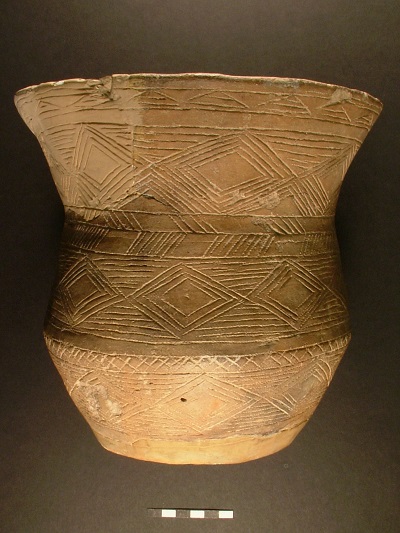This Beaker was one of two placed upside-down in the filling of one of the chambers of West Kennet long barrow, and dates to about 2,400BC. It may have been an offering to the ancestors, placed during the closing down of the long barrow.
3D Model
The Beaker was scanned for 'Ghosts of the Stone Age' - a programme in the Unearthed Series by Windfall Films for the Discovery Channel.
About West Kennet Long Barrow
People came together to bury their dead in long barrows. When first built, the mounds were gleaming white chalk, visible for miles around.
West Kennet Long Barrow is 100 metres in length with a burial chamber at its eastern end, facing the morning sun at the equinox, in March and October. At this time of year, the sun would have shone down the a stone-lined passage and lit up the central chamber at the end. The passage was lined by four side chamber built of massive sarsen stones. At least 45 men, women and children were buried there; all had died within a few years of each other in about 3,600BC. They were not placed in the chambers as complete bodies, but were left out in the open air to decompose, and only parts of the bodies were placed inside the tomb. Some bones were neatly arranged inside the chambers in groups of similar types, while others lay in a jumble on the floor.
The area outside the long barrow was large enough for many people to take part in ceremonies. However, there was only enough space for two or three people to go into the dark narrow passage leading to the chambers. The walls were damp and the only light was from flickering lamps. Did it feel like entering another world? Did it trigger visions of the spirits of the ancestors?
The tomb remained open, allowing people to return to pay their respects to the bones of their ancestors. Only after a thousand years were the chambers filled with chalk rubble. Finally, enormous blocks of sarsen stone were dragged into place to seal the entrance to the barrow leaving an imposing landmark.
Excavating West Kennet
This famous long barrow has been excavated twice, revealing remarkable evidence of Neolithic burial practices. Clues from these excavations and evidence from similar sites suggest that it was built in several stages.
Dr John Thurnam (1810-1873 )
Psychiatrist and archaeologist, Dr John Thurnam, was Medical Superintendent of Wiltshire County Lunatic Asylum in Devizes. Thurnam was fascinated by the study of human skulls and so in 1859 he excavated part of the end burial chamber of West Kennet Long Barrow. He was searching for specimens to include in his book, Crania Britannica: Delineations and Descriptions of the Skulls of the Aboriginal and Early Inhabitants of the British Islands, published in 1865. A thick layer of chalk rubble containing bone, flint and pottery was dug away from inside the chamber, revealing the skull of one child and five adult burials.
Stuart Piggott (1910-1996)
Stuart Piggott is a legendary figure in British Archaeology who defined the early Bronze Age ‘Wessex Culture’. He began his career as Alexander Keiller's deputy on excavations at Avebury in the 1930s. He taught in Scotland and worked all over the world, but ‘archaeologically and emotionally his heart belonged to Wessex’. Together with Richard Atkinson, he later excavated at Stonehenge and West Kennet Long Barrow. The barrow was excavated by Stuart Piggott in 1955 and 1956 and was featured in a very early BBC television broadcast. Many of the stones were re-erected so that the chambers could be opened to visitors. Piggott was a long-term supporter of this museum and President of the Wiltshire Archaeological and Natural History Society.


